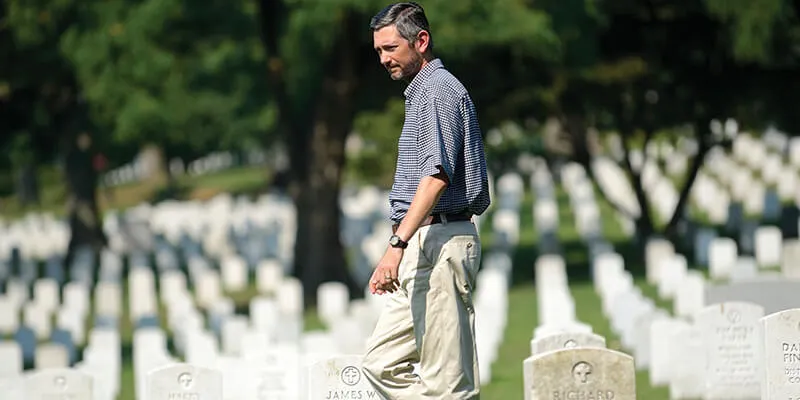It’s a humid summer morning at Arlington National Cemetery, just across the Potomac from Washington, D.C., but seemingly a long way from its bustle. Heavy mist hangs in the low ground as rays of sun break through the clouds, illuminating rows of white headstones that stretch endlessly into the distance. Flags wave lazily in the breeze, as birds flit between flowering trees. For now, the cemetery is, as you might expect, quiet. But by day’s end, thousands of visitors, ninety groundskeepers, and somewhere between twenty and thirty funeral services will transform Arlington with activity.
Seeing these 624 stunning acres in the peaceful early morning hours, says Greg Huse, is one of the best parts of his job as Arlington’s urban forester. Huse, who graduated from UVM in 1994 with a degree in forestry, is the self-described “tree guy” here, the country’s premiere military cemetery. “We consider the trees living memorials,” says Huse. “In a way, just by being on the grounds and growing, they’re honoring those that are buried here.”
“Tree guy” is no small job: Arlington is home to more than 8,700 trees, with 369 different species and varieties at last count. “We cover a lot of ground,” Huse says with a smile, nodding in the direction of his colleague, Arlington’s agronomist Aaron Pettit, who looks after about 440 football fields worth of turf.
Among the trees in Huse’s care are magnificent old oaks in the cemetery’s original sections, which trace back to Robert E. Lee’s estate. “Several of them pre-date the first burials,” says Huse, “so they’re at least two hundred and fifty years old.” Arlington was designated a national cemetery in 1864 during the Civil War, and is now the resting place for service members from every American conflict. “I find it fascinating to think, what have these trees witnessed? Wars, the first Memorial Day.”
In addition to caring for ancient giants, Huse and team plant about 250 new trees every year. Diversity is better for the ecosystem, and increasing the variety of species helps Arlington continue to achieve higher levels of arboretum certification.
Huse is one of those rare people who knew what he wanted to do from an early age. He grew up in northern New Jersey, and spent vacations visiting his grandparents in New Hampshire (his grandfather was a 1923 UVM grad). “Their house was on the side of a mountain, so I was always out in the forest,” says Huse.
Once at UVM, Huse was completely immersed in the world of trees. He was active in the student chapter of the Society of American Foresters and spent lots of time with advisor Peter Hannah (now retired) and Professor Emeritus Carl Newton. Huse also remembers loving dendrology class with John Shane, now a lecturer emeritus. “Our class was in the woods doing field work, and John picked up a plant and said, ‘Does anybody know what this is?’ It was poison ivy, and everybody was freaking out,” laughs Huse. “He started rubbing it against his face, and taught us that some people just aren’t allergic. I will always remember that.”
Huse also studied abroad in Australia and did two internships. “I got a wonderful education that really set me up for having a great career in this field,” the alumnus says. He went on to work in forestry consulting, eventually moving into arboriculture, or managing individual trees versus whole populations, and took a break to hike the Appalachian Trail, which “reinforced my love of nature.”
Most recently, Huse was the Smithsonian’s arborist, where he cared for 1,850 trees in their gardens and museum grounds. “It was just madness,” says Huse. “I was right on the National Mall between the Capitol and the Washington Monument. Millions of people, sirens, helicopters, motorcades. Here, it’s very busy and active, but it’s a more manageable pace.”
One year into his job at Arlington, he’s still discovering new things on those early morning strolls through the cemetery. “I’ll see a monument I haven’t noticed, or a tree in a certain light,” Huse says. “It’s very rewarding and humbling to have that juxtaposition of life and death and to have the responsibility to care for these living memorials.”
